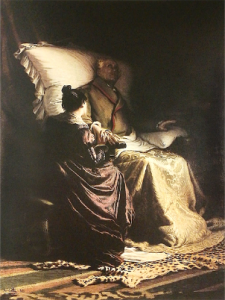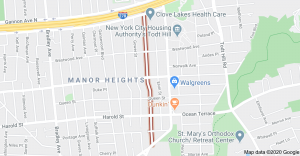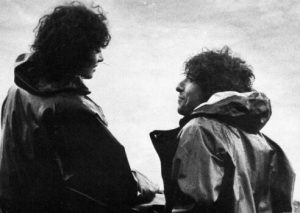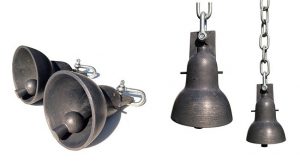by Jochen Markhorst
In 1997 Dylan surprises friend and foe with the album Time Out Of Mind. It’s the second time he entrusts the production to Daniel Lanois (after Oh Mercy, 1989), and that works out well this time too. Of course, for the first time since Oh Mercy, Dylan has very strong songs again, gaining strength through Lanois’ spherical, dark production, which recognizes the added value of Dylan’s grit.
There are more breathtaking songs on the album (“Tryin’ To Get To Heaven”, for instance, and the world hit “Make You Feel My Love”), but the dark pearl “Not Dark Yet” stands out above all else.
It is a monumental song, just like “Desolation Row” and “Where Are You Tonight?”, too impressive to discuss in one article – today part 1, about the first verse.
I Mehr Licht
Shadows are fallin’ and I’ve been here all day
It’s too hot to sleep and time is runnin’ away
Feel like my soul has turned into steel
I’ve still got the scars that the sun didn’t heal
There’s not even room enough to be anywhere
It’s not dark yet but it’s gettin’ there
 We owe it to Dr. Carl Vogel that we know Goethe’s last words, or, more specifically: the revised reconstruction of that finale: “Mehr Licht (More light)”.
We owe it to Dr. Carl Vogel that we know Goethe’s last words, or, more specifically: the revised reconstruction of that finale: “Mehr Licht (More light)”.
Vogel, Goethe’s physician, was in the room next door during the last minutes on March 22nd, 1832. Other persons, who were present in the bedroom, report something like “Open the other hatch, so that there be more light,” or correct the quotation to the equally romantic variant “Mehr nicht (No more)”. And Goethe’s daughter-in-law Ottilie, also present, later revealed that the old poet, very profane, in his last moments asked his servant Friedrich Krause for the “Botschampfer“, the chamber pot.
All more realistic and more likely, but a year later, in 1833, Dr. Carl Vogel publishes his Journal der practischen Heilkunde (“Journal of practical medicine”) containing the words that would become famous:
“More light,” are said to have been, while I had left the death chamber for a moment, the last words of the man who hated darkness in every respect.
“The last words of the man who hated darkness in every respect”… being, obviously, far more attractive than something as banal as I have to pee. Dr. Vogel’s intervention is defensible.
The court physician’s poetic instinct is admirable. Approaching darkness as a metaphor for dying has been a popular image among artists for centuries. Especially in literature (Heart Of Darkness, Voyage Au Bout De La Nuit, “Do Not Go Gentle Into That Good Night”, to name but three relatively recent examples), but just as popular with painters, of course. David’s “Death of Marat”, the dark skies of Carel Willink, and Morbelli’s painted impression of Goethe’s time of death is striking as well: on Goethe Morente (1880) the light falls on Ottilie, the great poet’s head fades into darkness. Not dark yet, but getting there.
Goethe himself was also receptive to the dramatic power of darkness; Werther commits suicide on 21 December, the shortest, i.e. darkest day of the year, at midnight. Faust I ends in a dark cell with the death of Gretchen, at the end of the night – the darkest hour right before the dawn.
Although the metaphor is too universal to draw a line from Goethe to Dylan’s “Not Dark Yet”, the artistic congeniality with Goethe and, as Professor Ricks passionately argues, with Keats but especially with later generations of poets in the heart of the Old Continent is unmistakable – Rilke and Trakl, in particular.
The Marilyn Monroe of the European fin-de-siècle lyricism is Rilke’s early masterpiece “Herbsttag” (“Autumn Day”, 1902). It’s a rather short poem that, unlike most poems in the canon, does not survive because of an unforgettable opening (like “April is the cruellest month”), or one memorable, quotable verse (“Two roads diverged in a wood”), but rather because of its overall perfection, from the superb opening line to the supreme last line.
Not only in that respect, “Herbsttag” is comparable to Dylan’s dark pearl “Not Dark Yet”. Rilke’s opening, and with it the theme, is identical too:
Herr: es ist Zeit. Der Sommer war sehr groß.
Leg deinen Schatten auf die Sonnenuhren,
und auf den Fluren laß die Winde los.
Lord: it is time. The summer was immense.
Lay your shadow on the sundials
and in the fields let loose the winds.
Identical imagery (the shadows depicting the approach of death), the same observation regarding the passage of Time without the narrator, and the withdrawal from the world, the loss of Space – great minds think alike, apparently.
However, it is not limited to Rilke, the kinship of “Not Dark Yet” with the decadent grandeur of the dying days of the Danube monarchy. If one of Dylan’s works, in terms of elegance, choice of words and visual power, fits into a Vienna of roughly 1910, into the downfall melancholy of the Austro-Hungarian Empire, it is this song.
With another giant of those days, from that part of the world, the kinship is at least as demonstrable and just as remarkable; with the Austrian poet Georg Trakl (1887-1914), one of the most important poets of Expressionism. Immortalized by his last poem, the terrifying war memorial “Grodek”, which he wrote just before his (presumed) suicide, but the congeniality with Dylan is evident in many more of his works. The majestic “Psalm” (1912) for example, which in itself already looks like a preliminary study for “A Hard Rain’s A-Gonna Fall”, and of which on a detailed level the synesthetic images, the melancholic tone and the trench jargon echo in songs like “Gates Of Eden”, “Jokerman” and “Not Dark Yet”:
Auf silbernen Sohlen gleiten frühere Leben vorbei
Und die Schatten der Verdammten steigen zu den seufzenden Wassern nieder
Former lives glide past on silver feet
And the shadows of the damned descend to sighing waters.
“Former lives glide past on silver feet”… the beauty, visual power and autumnal melancholy of such a verse paints in seven words the same Great Emotion as Dylan’s “Not Dark Yet”; the cocktail of feelings, insights and stillness on the threshold of death, the musings of an old man at the end of his life. As Trakl’s next line, “And the shadows of the damned descend to sighing waters“, summarizes in one line the content of Dylan’s masterpiece.
Producer Daniel Lanois does not make that connection with the Austro-Hungarian Dual Monarchy of a century and a half ago, but is close – by acknowledging an ancient trench feeling:
“There’s always going to be a sense of discovery with Bob because, at the last second, without warning and as the “record” button is pressed, he’ll change the key and time signature! Then musicians will just look at themselves and dribble in and often Bob will say “that’s it”. That happened in at least half the tracks on this album. Not Dark Yet had a radically different feel in the demo we did, which I loved and still miss. It was quicker and more stripped down and then, in the studio, he changed it into a civil war ballad.”
(interview Irish Times, 24 oktober 1997)
“A civil war ballad”? It’s hard to tell wherein Lanois does hear that or of what he is thinking. “Dixie”? “When Johnny Comes Marching Home”? “John Brown’s Body”? None of the standard civil war ballads seem to have a link to Dylan’s “Not Dark Yet”. Lanois explicitly doesn’t mean the lyrics though, but rather the musical accompaniment. However, the feel of civil war ballads is not discernible there either; they are usually quicker and more stripped down – like for instance Dylan’s own civil war ballad, “John Brown”. At best, the “feel” corresponds with the war ballad “’Cross The Green Mountain”, which Dylan will write a few years later for the film epic about the American Civil War, God And Generals (2003) – but obviously, Lanois does not know that song at the time of the interview.
No, presumably Lanois’ association is driven more by the Walt Whitman-“feel” of the lyrics than by the slowing down of the musical accompaniment, which apparently was more up-tempo originally.
Still, “Walt Whitman” is hardly more than an instinctive link. Very demonstrable influence of the great American poet there is not in this “Not Dark Yet”, at least not as tangible as a quarter of a century later in “I Contain Multitudes” (2020). The album title could have been inspired by Whitman’s “Song Of The Broad-Axe” (“Served those who, time out of mind, made on the granite walls rough / sketches of the sun, moon, stars, ships, ocean-waves”), and from Whitman’s continuous preoccupation with Time and Space, lines can also be drawn, just like from his weakness for shadows (undoubtedly in the Top 10 of Whitman’s most used nouns, along with soul), but that’s about it.
In the end the choice of words is, just like the theme at all, too universal to lead back to one admired work or one admired poet. If so, then Paul McCartney would be an even better candidate:
Suddenly, I’m not half the man I used to be
There’s a shadow hanging over me
Oh, yesterday came suddenly
Jimmy LaFave:
Untold Dylan: who we are what we do
Untold Dylan is written by people who want to write for Untold Dylan. It is simply a forum for those interested in the work of the most famous, influential and recognised popular musician and poet of our era, to read about, listen to and express their thoughts on, his lyrics and music.
We welcome articles, contributions and ideas from all our readers. Sadly no one gets paid, but if you are published here, your work will be read by a fairly large number of people across the world, ranging from fans to academics who teach English literature. If you have an idea, or a finished piece send it as a Word file to Tony@schools.co.uk with a note saying that it is for publication on Untold Dylan.
We also have a very lively discussion group “Untold Dylan” on Facebook with approaching 5000 active members. Just type the phrase “Untold Dylan” in, on your Facebook page or follow this link
You’ll find some notes about our latest posts arranged by themes and subjects on the home page of this site. You can also see details of our main sections on this site at the top of this page under the picture. Not every index is complete but I do my best.
But what is complete is our index to all the 604 Dylan compositions and co-compositions that we have found, on the A to Z page. I’m proud of that; no one else has found that many songs with that much information. Elsewhere the songs are indexed by theme and by the date of composition. See for example Bob Dylan year by year.



 I walked all night long with my 32-20 in my hand
I walked all night long with my 32-20 in my hand
